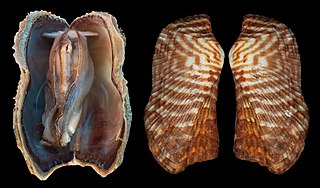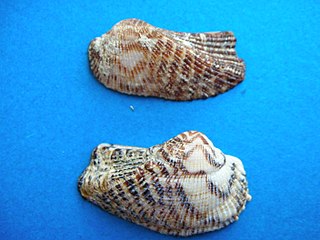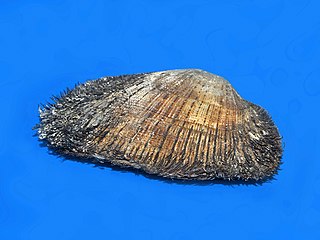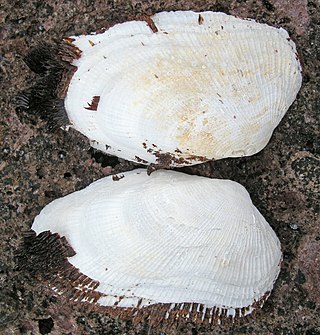
Clam is a common name for several kinds of bivalve molluscs. The word is often applied only to those that are edible and live as infauna, spending most of their lives halfway buried in the sand of the seafloor or riverbeds. Clams have two shells of equal size connected by two adductor muscles and have a powerful burrowing foot. They live in both freshwater and marine environments; in salt water they prefer to burrow down into the mud and the turbidity of the water required varies with species and location; the greatest diversity of these is in North America.

Mussel is the common name used for members of several families of bivalve molluscs, from saltwater and freshwater habitats. These groups have in common a shell whose outline is elongated and asymmetrical compared with other edible clams, which are often more or less rounded or oval.

Bivalvia, in previous centuries referred to as the Lamellibranchiata and Pelecypoda, is a class of marine and freshwater molluscs that have laterally compressed bodies enclosed by a shell consisting of two hinged parts. As a group, bivalves have no head and they lack some usual molluscan organs, like the radula and the odontophore. The class includes the clams, oysters, cockles, mussels, scallops, and numerous other families that live in saltwater, as well as a number of families that live in freshwater. The majority are filter feeders. The gills have evolved into ctenidia, specialised organs for feeding and breathing. Most bivalves bury themselves in sediment, where they are relatively safe from predation. Others lie on the sea floor or attach themselves to rocks or other hard surfaces. Some bivalves, such as the scallops and file shells, can swim. Shipworms bore into wood, clay, or stone and live inside these substances.

A cockle is an edible marine bivalve mollusc. Although many small edible bivalves are loosely called cockles, true cockles are species in the family Cardiidae.

The hard clam, also known as the round clam, hard-shellclam, or the quahog, is an edible marine bivalve mollusk that is native to the eastern shores of North America and Central America from Prince Edward Island to the Yucatán Peninsula. It is one of many unrelated edible bivalves that in the United States are frequently referred to simply as clams. Older literature sources may use the systematic name Venus mercenaria; this species is in the family Veneridae, the venus clams.

Barbatia is a genus of "bearded" ark clams, marine bivalve mollusks in the family Arcidae, the ark clams.

Anadara is a genus of saltwater bivalves, ark clams, in the family Arcidae. It is also called Scapharca.

The Atlantic surf clam, also called the bar clam, hen clam, skimmer or simply sea clam, is a very large, edible, saltwater clam or marine bivalve mollusk in the family Mactridae. It is one of the most commonly found species of bivalves in the western Atlantic Ocean. Able to reach sizes between 7.9 and 8.9 inches in length, Atlantic surf clams are much larger than Spisula solida, which also resides in the eastern Atlantic coastal waters. Atlantic surf clams reproduce in late summer, when the water temperatures peak.

Tegillarca granosa is a species of ark clam known as the blood cockle or blood clam due to the red haemoglobin liquid inside the soft tissues. It is found throughout the Indo-Pacific region from the eastern coast of South Africa northwards and eastwards to Southeast Asia, Australia, Polynesia, and up to northern Japan. It lives mainly in the intertidal zone at one to two metres water depth, burrowed down into sand or mud. Adult size is about 5 to 6 cm long and 4 to 5 cm wide.

Arca is a genus of edible saltwater clams in the family Arcidae, the Ark Clams.

Arca imbricata, or the Mossy ark clam, is a clam in the family Arcidae. It can be found along the Atlantic coast of North America, ranging from North Carolina to the West Indies, Brazil, and Bermuda.

Arca zebra, or the turkey wing ark clam, is a bivalve mollusc in the family Arcidae, the ark clams.

Barbatia cancellaria, or the Red-brown ark clam, is a clam in the family Arcidae. It can be found along the Atlantic coast of North America, ranging from Florida to the West Indies.

Barbatia domingensis, or the White miniature ark clam, was for many years a name that was commonly used for a marine clam in the family Arcidae.

Arca noae or the Noah's Ark shell is a species of bivalve mollusc in the family Arcidae. It is found in the Mediterranean Sea from low tide mark to a depth of 60 metres (200 ft).

Anadara kagoshimensis is an ark clam in the family Arcidae. It can be found in shallow water in temperate parts of the west Pacific Ocean and is cultivated in China, Japan, and Korea for human consumption. It is known as maohan in China and salubowgai(mogai) in Japan.

Barbatia barbata is a species of ark clam, a marine bivalve mollusk in the family Arcidae, the ark clams.

Tegillarca is a genus of molluscs of the family Arcidae, the Ark clams.

Barbatia reeveana, the low-rib ark or common Reeve's ark, is a species of bivalve mollusc. It was first described to science by Alcide d'Orbigny in 1846. It seems likely that the species is named for Lovell Augustus Reeve, an eminent conchologist of the day who was mentioned in d'Orbigny's original description of the species.





















